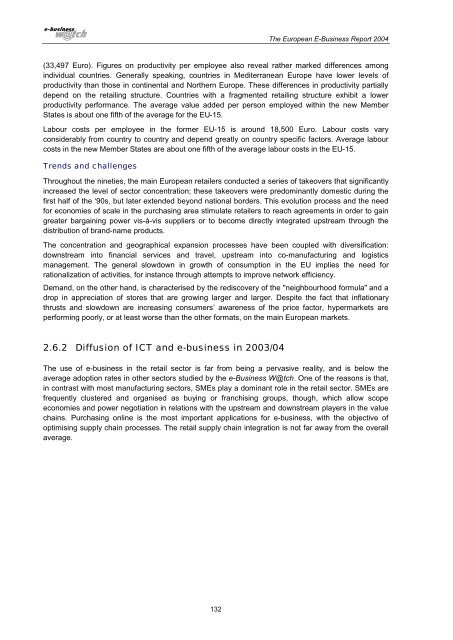The European e-Business Report 2004 - Berlecon Research GmbH
The European e-Business Report 2004 - Berlecon Research GmbH
The European e-Business Report 2004 - Berlecon Research GmbH
Create successful ePaper yourself
Turn your PDF publications into a flip-book with our unique Google optimized e-Paper software.
<strong>The</strong> <strong>European</strong> E-<strong>Business</strong> <strong>Report</strong> <strong>2004</strong>(33,497 Euro). Figures on productivity per employee also reveal rather marked differences amongindividual countries. Generally speaking, countries in Mediterranean Europe have lower levels ofproductivity than those in continental and Northern Europe. <strong>The</strong>se differences in productivity partiallydepend on the retailing structure. Countries with a fragmented retailing structure exhibit a lowerproductivity performance. <strong>The</strong> average value added per person employed within the new MemberStates is about one fifth of the average for the EU-15.Labour costs per employee in the former EU-15 is around 18,500 Euro. Labour costs varyconsiderably from country to country and depend greatly on country specific factors. Average labourcosts in the new Member States are about one fifth of the average labour costs in the EU-15.Trends and challengesThroughout the nineties, the main <strong>European</strong> retailers conducted a series of takeovers that significantlyincreased the level of sector concentration; these takeovers were predominantly domestic during thefirst half of the ‘90s, but later extended beyond national borders. This evolution process and the needfor economies of scale in the purchasing area stimulate retailers to reach agreements in order to gaingreater bargaining power vis-à-vis suppliers or to become directly integrated upstream through thedistribution of brand-name products.<strong>The</strong> concentration and geographical expansion processes have been coupled with diversification:downstream into financial services and travel, upstream into co-manufacturing and logisticsmanagement. <strong>The</strong> general slowdown in growth of consumption in the EU implies the need forrationalization of activities, for instance through attempts to improve network efficiency.Demand, on the other hand, is characterised by the rediscovery of the "neighbourhood formula" and adrop in appreciation of stores that are growing larger and larger. Despite the fact that inflationarythrusts and slowdown are increasing consumers’awareness of the price factor, hypermarkets areperforming poorly, or at least worse than the other formats, on the main <strong>European</strong> markets.2.6.2 Diffusion of ICT and e-business in 2003/04<strong>The</strong> use of e-business in the retail sector is far from being a pervasive reality, and is below theaverage adoption rates in other sectors studied by the e-<strong>Business</strong> W@tch. One of the reasons is that,in contrast with most manufacturing sectors, SMEs play a dominant role in the retail sector. SMEs arefrequently clustered and organised as buying or franchising groups, though, which allow scopeeconomies and power negotiation in relations with the upstream and downstream players in the valuechains. Purchasing online is the most important applications for e-business, with the objective ofoptimising supply chain processes. <strong>The</strong> retail supply chain integration is not far away from the overallaverage.132
















